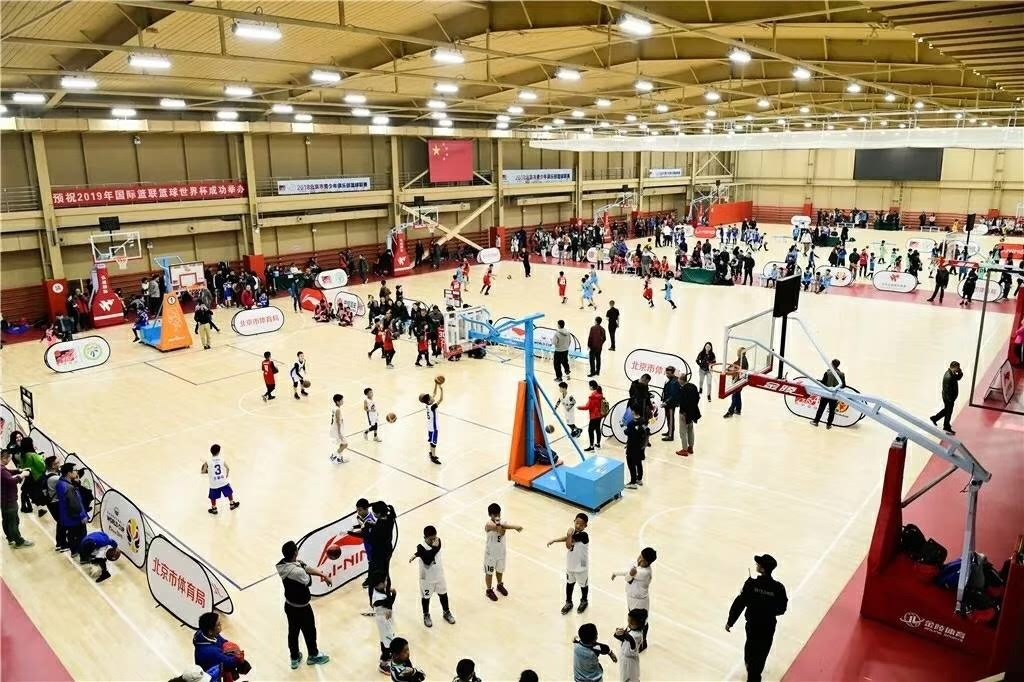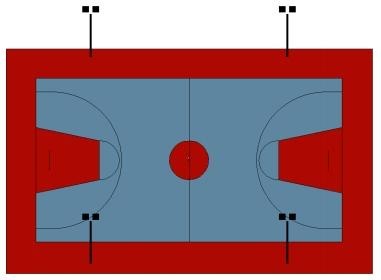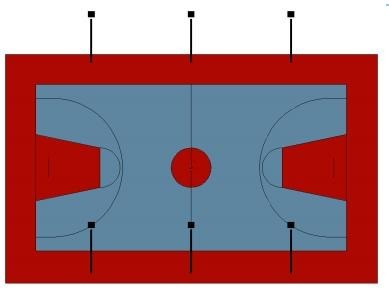Το σύστημα φωτισμού είναι πολύπλοκο αλλά ένα πολύ σημαντικό μέρος του σχεδιασμού του σταδίου.Όχι μόνο ικανοποιεί τις απαιτήσεις των παικτών και του κοινού, αλλά ικανοποιεί και τις απαιτήσεις φωτισμού της μετάδοσης σε πραγματικό χρόνο όσον αφορά τη θερμοκρασία χρώματος, τη φωτεινότητα και την ομοιομορφία, κάτι που είναι πιο σημαντικό από το πρώτο.Επιπλέον, η μέθοδος διανομής φωτός θα πρέπει να είναι συνεπής με το συνολικό σχέδιο του σταδίου, ειδικά η συντήρηση του εξοπλισμού φωτισμού θα πρέπει να σχετίζεται στενά με τον αρχιτεκτονικό σχεδιασμό.
ΑΠΑΙΤΗΣΕΙΣ ΦΩΤΙΣΜΟΥ
Τα πρότυπα φωτισμού για το κλειστό γήπεδο μπάσκετ είναι τα παρακάτω.
| ΕΛΑΧΙΣΤΑ ΕΠΙΠΕΔΑ ΦΩΤΙΣΜΟΥ (εσωτερικό) | Οριζόντιος φωτισμός E med (lux) | Ομοιομορφία E min/E med | Μάθημα φωτισμού | ||
| Διεθνείς διοργανώσεις επιπέδου FIBA 1 και 2 (μισό έως 1,50 μέτρα πάνω από τον αγωνιστικό χώρο) | 1500 | 0,7 | Τάξη Ⅰ | ||
| Διεθνείς και εθνικούς αγώνες | 750 | 0,7 | Τάξη Ⅰ | ||
| Περιφερειακοί αγώνες, προπόνηση υψηλού επιπέδου | 500 | 0,7 | Τάξη Ⅱ | ||
| Τοπικοί αγώνες, σχολική και ψυχαγωγική χρήση | 200 | 0,5 | Κατηγορία Ⅲ | ||
Τα πρότυπα φωτισμού για υπαίθριο γήπεδο μπάσκετ είναι τα παρακάτω.
| ΕΛΑΧΙΣΤΑ ΕΠΙΠΕΔΑ ΦΩΤΙΣΜΟΥ (εσωτερικό) | Οριζόντιος φωτισμός E med (lux) | Ομοιομορφία E min/E med | Μάθημα φωτισμού | ||
| Διεθνείς και εθνικούς αγώνες | 500 | 0,7 | Τάξη Ⅰ | ||
| Περιφερειακοί αγώνες, προπόνηση υψηλού επιπέδου | 200 | 0.6 | Τάξη Ⅱ | ||
| Τοπικοί αγώνες, σχολική και ψυχαγωγική χρήση | 75 | 0,5 | Κατηγορία Ⅲ | ||
Σημειώσεις:
Τάξη Ι: Περιγράφει τους κορυφαίας κατηγορίας, διεθνείς ή εθνικούς αγώνες μπάσκετ, όπως το NBA, το τουρνουά NCAA και το Παγκόσμιο Κύπελλο FIBA.Το σύστημα φωτισμού θα πρέπει να είναι συμβατό με τις απαιτήσεις εκπομπής.
Κατηγορία II:Το παράδειγμα εκδήλωσης κατηγορίας ΙΙ είναι ο περιφερειακός διαγωνισμός.Το πρότυπο φωτισμού είναι λιγότερο έντονο καθώς συνήθως περιλάμβανε μη τηλεοπτικά γεγονότα.
Τάξη III:Εκπαιδευτικές ή ψυχαγωγικές εκδηλώσεις.
ΑΠΑΙΤΗΣΕΙΣ ΠΗΓΗΣ ΦΩΣ:
- 1. Τα στάδια υψηλής εγκατάστασης θα πρέπει να χρησιμοποιούν πηγές φωτός SCL LED με μικρή γωνία δέσμης.
2. Τα χαμηλά ταβάνια, τα μικρότερα εσωτερικά γήπεδα θα πρέπει να χρησιμοποιούν αθλητικά φώτα LED με χαμηλότερη ισχύ και μεγαλύτερες γωνίες δέσμης.
3. Οι ειδικοί χώροι πρέπει να χρησιμοποιούν αντιεκρηκτικά φώτα σταδίου LED.
4. Η ισχύς της πηγής φωτός πρέπει να προσαρμόζεται στο μέγεθος, τη θέση εγκατάστασης και το ύψος του αγωνιστικού χώρου ώστε να ταιριάζει σε υπαίθριους αθλητικούς χώρους.Τα φώτα σταδίου LED υψηλής ισχύος θα πρέπει να χρησιμοποιούνται για να διασφαλίζεται η αδιάλειπτη λειτουργία και η γρήγορη εκκίνηση των πηγών φωτός LED.
5. Η πηγή φωτός πρέπει να έχει κατάλληλη θερμοκρασία χρώματος, καλό δείκτη απόδοσης χρώματος, υψηλή απόδοση φωτός, μεγάλη διάρκεια ζωής, σταθερή ανάφλεξη και φωτοηλεκτρική απόδοση.
Η συσχετισμένη θερμοκρασία χρώματος και η εφαρμογή της πηγής φωτός είναι όπως παρακάτω.
| Συσχετισμένη θερμοκρασία χρώματος (Κ) | Έγχρωμος πίνακας | Εφαρμογή σταδίου | |||
| 3300 £ | Ζεστό χρώμα | Μικρός χώρος προπόνησης, ανεπίσημος χώρος αγώνα | |||
| 3300-5300 | Ενδιάμεσο χρώμα | Τόπος προπόνησης, αγωνιστικός χώρος | |||
| 5300 ﹥ | Κρύο χρώμα | ||||
ΣΥΣΤΑΣΗ ΕΓΚΑΤΑΣΤΑΣΗΣ
Η θέση των φώτων είναι κρίσιμη για τη συμμόρφωση με τις απαιτήσεις φωτισμού.Πρέπει να διασφαλίζει ότι μπορούν να επιτευχθούν οι απαιτήσεις φωτισμού, χωρίς να παρεμποδίζει την ορατότητα των παικτών και να μην δημιουργεί λάμψη προς την κύρια κάμερα.
Όταν έχει καθοριστεί η θέση της κύριας κάμερας, οι πηγές αντανάκλασης μπορούν να ελαχιστοποιηθούν αποφεύγοντας την εγκατάσταση φώτων στην απαγορευμένη περιοχή.
Οι λαμπτήρες και τα εξαρτήματα θα πρέπει να συμμορφώνονται πλήρως με τις απαιτήσεις επιδόσεων ασφαλείας των σχετικών προτύπων.
Η στάθμη ηλεκτροπληξίας των λαμπτήρων πρέπει να πληροί τις ακόλουθες απαιτήσεις: θα πρέπει να χρησιμοποιείται με γειωμένα μεταλλικά φωτιστικά εργασίας ή λαμπτήρες κατηγορίας ΙΙ και πισίνες και παρόμοια μέρη θα πρέπει να χρησιμοποιούνται για λαμπτήρες κατηγορίας III.
Η τυπική διάταξη ιστού για γήπεδα ποδοσφαίρου είναι η παρακάτω.
Ώρα δημοσίευσης: Μάιος-09-2020



